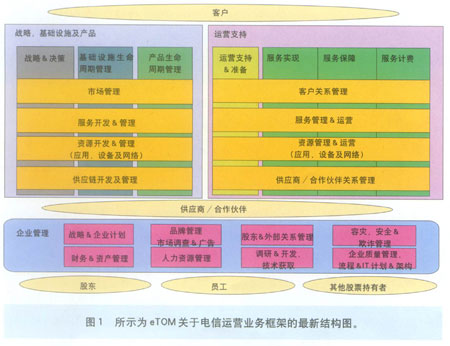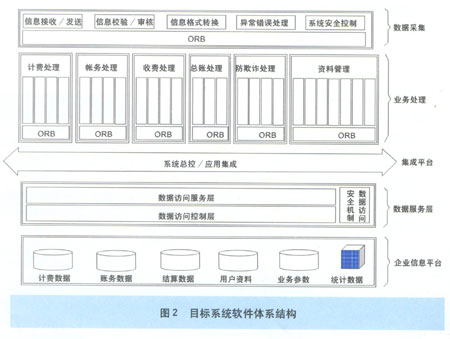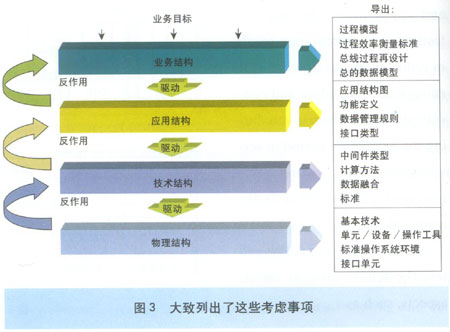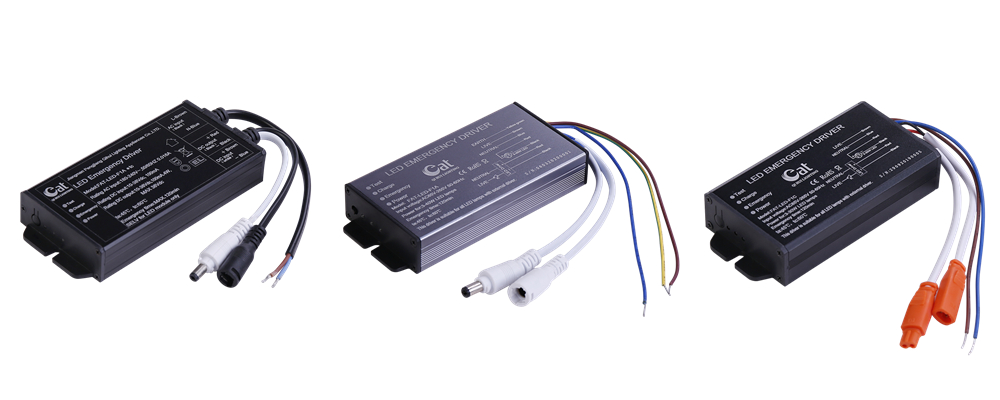Analysis of the New Generation Telecom Operation Support System
This article discusses the structure of a new generation of telecommunication operation support system in combination with international and domestic situations, and puts forward several issues that should be paid attention to during construction.
Keywords: NGOSS; BSS / OSS; telecom operation business framework; architecture; test
Recently, BSS / OSS has become a hot spot in the industry. On the occasion of China Mobile's BSS / OSS, China Telecom, China Netcom, China Unicom and other domestic telecom operators are also actively taking action. Why is the new generation of telecom operation support system (NGOSS) centered on BSS / OSS the new focus of China's telecom operation industry? What will it bring to Chinese operators? This article hopes that through the discussion of the new generation of telecommunication operation support system (NGOSS), it will help to build and develop our OSS system in a targeted manner, especially in system modeling, software development, middleware and other aspects.
1 GOSS embodies the requirements of the new era of operations
The new operating era has the following key characteristics: First, the operator ’s enterprise operation makes production efficiency and profit the core issues; second, the open and competitive market makes customers the focus of operators ’attention, and the competition for services is becoming increasingly fierce; third With the improvement and proximity of network technology strength, the competition between markets and services has become the key to the success of operators. The arrival of a new era of operations has brought an impact on the entire telecommunications operating architecture.
The TeleManagement Forum (TM Forum) gives nine reasons why telecom operators build OSS (OperaTIon Support System):
(1) Reduce production costs;
(2) Increase income quickly;
(3) Reduce risk;
(4) Reduce income loss (5) Increase sales;
(6) High return on investment;
(7) Support value-added services;
(8) Improve customer satisfaction;
(9) Reduce operating labor costs.
At present, the network coverage and technical level of China's telecommunications operators are among the highest in the world, but there is still a gap between the network management level, operation level, and efficiency level. After joining the WTO, telecom operators are faced with the question of "how to reduce costs and retain users". In addition to the increasing external pressure, the internal market is also under pressure. The major operators are working hard to solve this problem in various ways, and finally turn their attention to the NGOSS system.
The most critical feature of the new generation of telecommunication operation support system (NGOSS) is to have a high degree of system integration, to integrate and connect a variety of separate business systems to form a unified whole, and realize internal and external business processes The smooth accessibility and unified coordination of the company, so as to achieve the overall improvement of enterprise management level, operational efficiency, service capabilities and other aspects.
Therefore, the new generation of telecommunication operation support system (NGOSS) conforms to the requirements of the new operation era.
2 TOM and eTOM
The NGOSS proposed by TM Forum involves a lot of content. Among them, the telecom operation business framework (TOM) is proposed as a system model, which can be said to be an aspect of the NGOSS outline. TOM was originally proposed as a blueprint to guide the process of telecommunications enterprises and the starting point of the operation support system. When it was formally published in 1998, it was named the telecom operation description.
At present, TOM's model has been widely used. When discussing problems and dividing software functions and modules, telecommunications operators and software developers start with three levels: implementation, guarantee, and billing, customer management, business management, network, and equipment management.
eTOM developed TOM. According to the explanation of TM Forum, the "e" in eTOM means:
(1) Enterprise processes;
(2) Provide e-commerce capabilities (eBusiness enabled);
(3) Improvement (Enhanced);
(4) Expanded (Expanded);
(5) Everything, place, time (Everything, Everywhere, EveryTIme);
(6) Wait a minute (Etc.).

TOM is extended from the general network management to the full range of OSS, eTOM is further extended to the OSS / BSS of telecommunications companies. Compared with TOM, eTOM has made the following expansions:
(1) eTOM extends the TOM model to the activities of the entire enterprise, not just the operation of telecommunications services. It includes all aspects of the company's strategic planning, enterprise infrastructure, enterprise product planning and so on. In addition to involving customers, it also involves employees of the enterprise, holders of enterprise shares, etc.
(2) Due to the importance of the marketing process in an e-commerce environment, this process is specifically defined in eTOM.
(3) The enterprise management process is specifically defined. The purpose of this is to enable eTOM to guide the activities of the entire enterprise, so that all organizations in the enterprise can identify important production / management processes within the scope of responsibility.
(4) Put Fulfillment, Assurance and Billing (FAB) in the high-level view of the overall model to emphasize that the customer-centric process is the key process of the enterprise.
(5) Define a vertical process group for operation support and preparation. In addition to the enterprise management level, the process group runs through all functional levels (customer relationship, business management and operation, resource management and operation, supplier / partner relationship management). This is to realize the functions of e-commerce and customer self-management. In the future, with the improvement of the OSS system and the development of the Internet and e-commerce, the online operation process of customers will become more and more important.
(6) Three enterprise process groups different from functional operations and customer operation processes were identified. These three process groups form the SIP (strategy, infrastructure life cycle management, product cycle management) process.
(7) Confirm that the SIP process and various business operation processes related to customers have different management cycles. In terms of the operating cycle of daily operations, the two processes are separated.
(8) From customer-oriented service or business to customer-oriented relationship management. This is to emphasize customer self-management and control, enhance customer value to the enterprise, and provide better personalized services to customers. Customer-oriented management gives customers a richer level of operation, which can better represent the sales process and combine marketing implementation with customer relationship management. eTOM's customer relationship management will have a broader meaning and extension than some CRM definitions.
(9) In TOM, the management of IT is vertical management without layers. ETOM recognizes the unified management of IT and redefines the network and system management process into resource management and operation, including the management of system information.
OSS is expanding to the scope covered by eTOM. Applications in this area include: partner management applications, telecommunications customer relationship management applications, planning and asset management applications, etc.
3 NGOSS support for new business and new technology
An important goal of NGOSS is to achieve end-to-end management. To achieve this goal, it is necessary to automate the management of communication resources. In today's rapid development of telecommunications services and telecommunications technology, this is a very challenging task.
Studies have shown that telecommunications technology is developing in the following directions:
(1) Bundled service offerings;
(2) IP-based networks;
(3) Fiber opTIcs;
(4) Wireless data;
(5) SoftSwitch & VoIP;
(6) Internet;
(7) GPS.
The telecommunications network supports increasingly diversified telecommunications services and puts forward new requirements for network and equipment management. For example, the management of service quality, the problem of providing different charging rates and charging methods for services with different traffic characteristics and different service quality, and so on. The telecommunication equipment and telecommunication technologies supporting new telecommunication services are also diversifying. To complete the end-to-end management, we must effectively manage and support these accesses. The emergence of new technologies and new services is very rapid, and the upgrade and update of the operation support system for these new technologies and new services has become the daily task of NGOSS.
NGOSS must support new technologies and new services. For example, the current mobile business is developing very rapidly, and the mobile communication system is transitioning from the second generation to the third generation. With the development of mobile communication system technology and the improvement of mobile communication system performance and functions, more and more mobile services can be provided. Various powerful services provided in a complex mobile technology environment, such as mobile commerce, mobile office, location-based services, etc., are undoubtedly a major challenge for the operation support system. Compared with traditional services, there are Many problems need to be solved. Whether it is an operator or a customer, the requirements for Service Level Agreements (SLAs) for these services are more urgent than in any previous business. Realizing automatic processing and end-to-end management of SLA is an important part of NGOSS. The operation support system not only affects the management support method, but also directly participates in the service to users in some aspects. In this sense, the boundaries between network and operations support management will become increasingly blurred. With the support of NGOSS, users can get more thoughtful and even brand-new services during and after the transition of the entire network.
4 Target system software architecture
The target system software architecture derived from the telecom operation business framework is mainly composed of enterprise information platform, data service layer, business processing and data collection. Among them, the enterprise information platform is the foundation of the entire system. The enterprise information platform is mainly composed of user data, business parameters, billing data, accounting data, settlement data and other information. The data service layer includes a data access service layer, a data access control layer, and a data access security mechanism. The data service layer ensures the security and control of business processes on data access to the enterprise information platform. The separation of enterprise data and business processing enhances the scalability and flexibility of business processing. See Figure 2 for details.

5 Issues to be noted in NGOSS construction
5.1 Architecture migration
Moving from current systems and architectures to new systems, architecture migration is a necessary task, but its complexity and high risk may also be incredible. In order to reduce risks as much as possible, it is obviously wise to implement changes in a structured and controlled way.
Figure 3 outlines these considerations. Each activity level promotes or is restricted by the next level.

5.2 Test
Most computer system failures are caused by insufficient testing at a certain stage. In fact, if a hardware failure occurs, even if the error is fixed, it may often cause the system to deteriorate due to the software's inability to recover (this process is often not tested).
The test environment can take many forms, the best form is of course to make a complete image of the system in use, including various hardware, system software, data and applications. Incomplete configuration of the test environment may result in reduced test accuracy. If you grasp and consider this in the evaluation phase of business release, you can fully grasp and manage the test environment.
Importantly, the entire process must be defined and tested for all aspects, such as:
(1) Test plan development;
(2) Preparation for test status;
(3) Test data preparation;
(4) Provide technical support for testing;
(5) Backup and return;
(6) Diagnosis;
(7) Performance test;
(8) Error ticket management;
(9) Repair and release;
(10) End;
(11) Return.
It is also important to ensure that infrastructure and test teams are in place before they are really needed, because training and stabilization processes can take a lot of time. In addition, business personnel should be motivated to discover problems proactively, not just to meet the bottom line requirements. If the tester is under undue pressure and must accept the system before the specified date, then the quality of the test will definitely be affected.
6 Conclusion
China's telecommunications industry is stepping into a new era of operation with more intense competition and more open markets, and a new generation of telecommunications operation support system NGOSS will play an important role in this process.
LED emergency power supply is a driver that can be used as backup power supply for LED lights . The Aluminum Shell Emergency Driver can be applied to all different types of LED lights in the wide range of AC85-265V . Aluminium housing can make the Emergency Conversion Kit faster heat dissipation , small density and light weight , with a strong corrosion resistance . Choose high quality rechargeable lithium ion battery to extend the service life .

Aluminum Shell Emergency Driver
Emergency Light Kit,Led Emergency Inverter,Led Emergency Backup Driver,Led Light With Emergency Backup
Jiangmen City Pengjiang District Qihui Lighting Electrical Appliances Co., Ltd , https://www.qihuilights.com
